
Hydrogen Cyanide Regulation by S-Cyanylation
Plant Physiology, Plant Physiology: On The InsideDespite its toxicity, cyanide has been proposed to act as a regulator of several biological processes such as seed dormancy and germination, resistance to fungal and viral infection. Arabidopsis null mutants of the mitochondrial enzyme β-CYANOALANINE SYNTHASE (CAS-C1) accumulate cyanide to apparently…
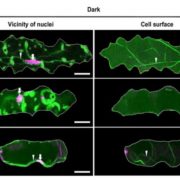
Dark-Induced Nuclear Positioning in Leaf Cells
Plant Physiology, Plant Physiology: On The InsideThe appropriate spatial arrangement of nuclei is essential for various cellular activities during cell division, growth, migration, and differentiation in eukaryotes. In plants, nuclear positioning is also required for proper responses to environmental stimuli, including pathogen infection, touch, temperature,…
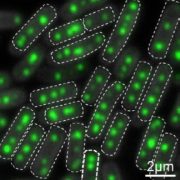
New Insights into Carboxysomes
Plant Physiology, Plant Physiology: On The InsideDespite its essential role in photosynthetic carbon fixation, ribulose 1,5 bisphosphate carboxylase/oxygenase (Rubisco) is a relatively inefficient enzyme, due in part to its inability to discriminate between CO2 and O2 as substrates. To suppress the oxygenase reaction and enhance the carboxylase activity…
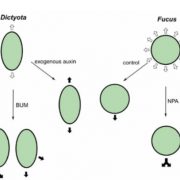
Auxin Function in a Brown Alga
Plant Physiology, Plant Physiology: On The InsideAuxin controls body plan patterning in land plants and it has been proposed to play a similar role in the development of brown algae (Phaeophyta) despite their distant evolutionary relationship with land plants. In flowering plants and many multicellular brown algae, the establishment of the apical-basal…

Plant Reactive Oxygen Species Enhance Virus Spread by Aphids
Plant Physiology, Plant Physiology: On The InsideHemipterans, a group of phloem-feeding insects that includes aphids, planthoppers, and whiteflies, are responsible for the spread of most plant viruses from plant to plant. Stylet positioning and feeding activities have important consequences for the acquisition and transmission of viruses by insect…
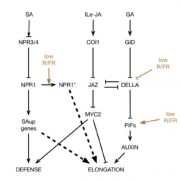
Salicylic Acid and Shade Avoidance
Plant Physiology, Plant Physiology: On The InsideIn response to shading, plants undergo a suite of developmental and physiological responses known as shade avoidance. In agricultural settings, dense planting can cause shade avoidance responses, thereby reducing yields due to changes in carbon allocation that favor stem elongation over seed, fruit,…
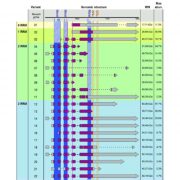
Temperature-Responsive RNA Metabolism Proteins in Algae
Plant Physiology, Plant Physiology: On The InsideGlobal climate change is currently affecting the growth and photosynthetic capacities of microalgae, which are major contributors to carbon fixation on Earth. The consequences of global climate change have already had dramatic effects on aquatic ecology. For example, thermal changes have led to coral…
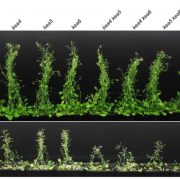
The H+/K+ Antiporters of Endosomal Membranes
Plant Physiology, Plant Physiology: On The InsideThe plant endomembrane system is comprised of the endoplasmic reticulum (ER), the Golgi complex, trans-Golgi network (TGN), pre-vacuolar compartment (PVC) and vacuoles. The endomembrane system, by enabling protein modification and sorting, plays important roles in cell polarity, cytokinesis, cell wall…

Regulation of Cortical Microtubule Array Patterns
Plant Physiology, Plant Physiology: On The InsideThe plant cortical microtubule array is a dynamic self-organizing structure that controls the mechanics of plant growth by guiding the deposition of wall materials. While much is known about the properties of individual microtubules, the mechanism by which plant cells organize the cortical array into…

